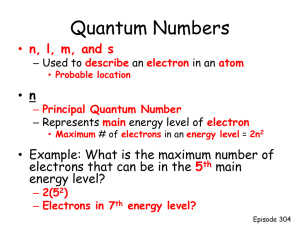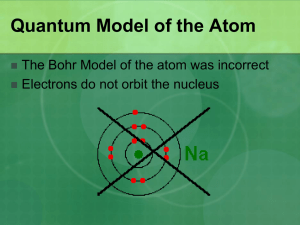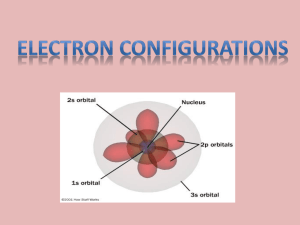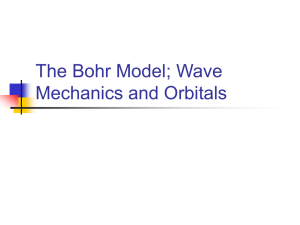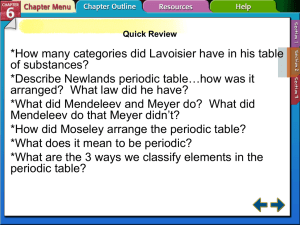Quantum
advertisement
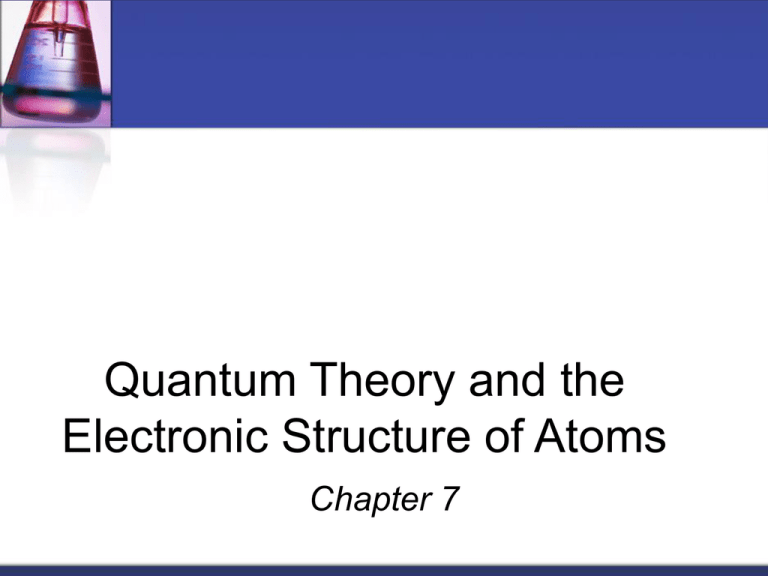
Quantum Theory and the Electronic Structure of Atoms Chapter 7 Properties of Waves Wavelength (l) is the distance between identical points on successive waves. Amplitude is the vertical distance from the midline of a wave to the peak or trough. 7.1 Properties of Waves Frequency (n) is the number of waves that pass through a particular point in 1 second (Hz = 1 cycle/s). The speed (u) of the wave = l x n 7.1 Maxwell (1873), proposed that visible light consists of electromagnetic waves. Electromagnetic radiation is the emission and transmission of energy in the form of electromagnetic waves. Speed of light (c) in vacuum = 3.00 x 108 m/s All electromagnetic radiation lxn=c 7.1 7.1 Relationship Between Frequency and Wavelength Frequency and Wavelength are inversely related C = ln Where c = speed of light, l is the wavelength, and n is the frequency Example 1 A photon has a frequency of 6.0 x 104 Hz. Convert this frequency into wavelength (nm). Does this frequency fall in the visible region? C = ln l = 3.00 x 108 m/s / 6.0 x 104 Hz l = 5.0 x 103 m l = 5.0 x 1012 nm No, this is a radio wave 7.1 Example 2 Red light has a wavelength that ranges from 7.0 x 10-7 m to 6.5 x 10-7 m. What is the frequency of light found in the red region? 3.0 x 108 m/s = (7.0 x 10-7 m)(n) n=4.29 x 1014 Hz 3.0 x 108 m/s = (6.5 x 10-7 m)(n) n=4.62 x 1014 Hz nrange=4.29 x 1014 Hz - 4.62 x 1014 Hz Example 3 A gamma ray has a frequency of 3.0 x 1021 Hz. What is the wavelength, in nm, of the ray? 3.0 x 108 = l(3.0 x 1021 s-1) l= 1.0 x 10-13 m l= 1.0 x 10-4 nm Mystery #1, “Black Body Problem” Solved by Planck in 1900 Energy had been thought to be emitted continuously at all wavelengths. However, energy (light) is emitted or absorbed in discrete units called quanta. E=hxn Planck’s constant (h) h = 6.626 x 10-34 J•s 7.1 Mystery #2, “Photoelectric Effect” Solved by Einstein in 1905 Discovered that light has both: 1. wave nature 2. particle nature hn KE e- Photon is a “particle” of light 7.2 Relationship Between Energy and Frequency E = hn h=Planck’s Constant h=6.626 x 10-34 J s This constant was determined experimentally Example 1 What is the energy of a wave that has a frequency of 1.05 x 1016 Hz? E = hn E = (6.626 x 10-34 J s)(1.05 x 1016 s-1) E = 6.96 x 10-18 J Example 2 What is the wavelength of a photon of light that has 4.79 x 10-19 J of energy? What color light is represented? E = hn 4.79 x 10-19 J = (6.626 x 10-34 J s) n n=7.23 x 1014 Hz c = ln 3.0 x 108 m/s = l (7.23 x 1014 s-1) l = 4.1 x 10-7 m; violet Line Emission Spectrum of Hydrogen Atoms 7.3 7.3 Bohr’s Model of the Atom (1913) 1. e- can only have specific (quantized) energy values 2. light is emitted as emoves from one energy level to a lower energy level En = -RH ( 1 n2 ) n (principal quantum number) = 1,2,3,… RH (Rydberg constant) = 2.18 x 10-18J 7.3 E = hn E = hn 7.3 ni = 3 ni = 3 ni = 2 nf = 2 Ephoton = DE = Ef - Ei 1 Ef = -RH ( 2 ) nf 1 Ei = -RH ( 2 ) ni 1 1 DE = RH( 2 ) 2 ni nf nnf f==11 7.3 Calculate the wavelength (in nm) of a photon emitted by a hydrogen atom when its electron drops from the n = 5 state to the n = 3 state. Ephoton = DE = RH( 1 n2i 1 n2f ) Ephoton = 2.18 x 10-18 J x (1/25 - 1/9) Ephoton = DE = -1.55 x 10-19 J Ephoton = h x c / l l = h x c / Ephoton l = 6.63 x 10-34 (J•s) x 3.00 x 108 (m/s)/1.55 x 10-19J l = 1280 nm 7.3 Why is e- energy quantized? De Broglie (1924) reasoned that the e- is both particle and wave (he called this the wave/particle duality). l= h/mn h=Planck’s Constant m=mass 7.4 What is the de Broglie wavelength (in nm) associated with a 2.5 g Ping-Pong ball traveling at 15.6 m/s? l = h/mn h in J•s m in kg n in (m/s) l = 6.63 x 10-34 J s/ (2.5 x 10-3 kg x 15.6 m/s) l = 1.7 x 10-32 m = 1.7 x 10-23 nm 7.4 Chemistry in Action: Element from the Sun In 1868, Pierre Janssen detected a new dark line in the solar emission spectrum that did not match known emission lines Mystery element was named Helium In 1895, William Ramsey discovered helium in a mineral of uranium (from alpha decay). Chemistry in Action: Electron Microscopy le = 0.004 nm STM image of iron atoms on copper surface Heisenberg’s Uncertainty Principle Heisenberg stated that it is impossible to know precisely both the velocity and the position of a particle *If you measure the position of a particle it will be disturbed therefore altering the velocity Schrodinger Wave Equation In 1926 Schrodinger wrote an equation that described both the particle and wave nature of the eEY = HY Wave function (Y) describes: 1. energy of e- with a given Y 2. probability of finding e- in a volume of space Schrodinger’s equation can only be solved exactly for the hydrogen atom. Must approximate its solution for multielectron systems. 7.5 Probability of Finding an Electron Max Born: later found it was more useful to determine the probability of finding an electron in a certain location Y2 QUANTUM NUMBERS The shape, size, and energy of each orbital is a function of 3 quantum numbers which describe the location of an electron within an atom or ion n (principal) ---> energy level l (orbital) ---> shape of orbital ml (magnetic) ---> designates a particular suborbital The fourth quantum number is not derived from the wave function s (spin) ---> spin of the electron (clockwise or counterclockwise: ½ or – ½) Schrodinger Wave Equation Y = fn(n, l, ml, ms) principal quantum number n n = 1, 2, 3, 4, …. distance of e- from the nucleus n=1 n=2 n=3 7.6 Where 90% of the e- density is found for the 1s orbital e- density (1s orbital) falls off rapidly as distance from nucleus increases 7.6 Schrodinger Wave Equation Y = fn(n, l, ml, ms) angular momentum quantum number l for a given value of n, l = 0, 1, 2, 3, … n-1 n = 1, l = 0 n = 2, l = 0 or 1 n = 3, l = 0, 1, or 2 l=0 l=1 l=2 l=3 s orbital p orbital d orbital f orbital Shape of the “volume” of space that the e- occupies 7.6 Types of Orbitals (l) s orbital p orbital d orbital l = 0 (s orbitals) l = 1 (p orbitals) 7.6 p Orbitals this is a p sublevel with 3 orbitals These are called x, y, and z 3py orbital There is a PLANAR NODE thru the nucleus, which is an area of zero probability of finding an electron p Orbitals three p orbitals lie 90o apart in space The l = 2 (d orbitals) 7.6 f Orbitals For l = 3, orbitals f sublevel with 7 Schrodinger Wave Equation Y = fn(n, l, ml, ms) magnetic quantum number ml for a given value of l ml = -l, …., 0, …. +l if l = 1 (p orbital), ml = -1, 0, or 1 if l = 2 (d orbital), ml = -2, -1, 0, 1, or 2 orientation of the orbital in space 7.6 ml = -1 ml = -2 ml = 0 ml = -1 ml = 0 ml = 1 ml = 1 ml = 2 7.6 Schrodinger Wave Equation Y = fn(n, l, ml, ms) spin quantum number ms ms = +½ or -½ ms = +½ ms = -½ 7.6 Schrodinger Wave Equation Y = fn(n, l, ml, ms) Existence (and energy) of electron in atom is described by its unique wave function Y. Pauli exclusion principle - no two electrons in an atom can have the same four quantum numbers. Each seat is uniquely identified (E, R12, S8) Each seat can hold only one individual at a time 7.6 7.6 Schrodinger Wave Equation Y = fn(n, l, ml, ms) Shell – electrons with the same value of n Subshell – electrons with the same values of n and l Orbital – electrons with the same values of n, l, and ml How many electrons can an orbital hold? If n, l, and ml are fixed, then ms = ½ or - ½ Y = (n, l, ml, ½) or Y = (n, l, ml, -½) An orbital can hold 2 electrons 7.6 How many 2p orbitals are there in an atom? n=2 2p If l = 1, then ml = -1, 0, or +1 3 orbitals l=1 How many electrons can be placed in the 3d subshell? n=3 3d l=2 If l = 2, then ml = -2, -1, 0, +1, or +2 5 orbitals which can hold a total of 10 e7.6 Orbital Diagrams Energy of orbitals in a multi-electron atom n=3 l = 2 n=3 l = 0 n=2 l = 0 n=3 l = 1 n=2 l = 1 Energy depends on n and l n=1 l = 0 7.7 “Fill up” electrons in lowest energy orbitals (Aufbau principle) 7.7 The most stable arrangement of electrons in subshells is the one with the greatest number of parallel spins (Hund’s rule). 7.7 Order of orbitals (filling) in multi-electron atom 1s < 2s < 2p < 3s < 3p < 4s < 3d < 4p < 5s < 4d < 5p < 6s 7.7 Why are d and f orbitals always in lower energy levels? d and f orbitals require LARGE amounts of energy It’s better (lower in energy) to skip a sublevel that requires a large amount of energy (d and f orbtials) for one in a higher level but lower energy This is the reason for the diagonal rule! BE SURE TO FOLLOW THE ARROWS IN ORDER! Electron configuration is how the electrons are distributed among the various atomic orbitals in an atom. number of electrons in the orbital or subshell 1s1 principal quantum number n angular momentum quantum number l Orbital diagram H 1s1 7.8 Outermost subshell being filled with electrons 7.8 Paramagnetic unpaired electrons 2p Diamagnetic all electrons paired 2p 7.8 7.8 Exceptions to the Aufbau Principle Remember d and f orbitals require LARGE amounts of energy If we can’t fill these sublevels, then the next best thing is to be HALF full (one electron in each orbital in the sublevel) There are many exceptions, but the most common ones are d4 and d9 For the purposes of this class, we are going to assume that ALL atoms (or ions) that end in d4 or d9 are exceptions to the rule. This may or may not be true, it just depends on the atom. Exceptions to the Aufbau Principle d4 is one electron short of being HALF full In order to become more stable (require less energy), one of the closest s electrons will actually go into the d, making it d5 instead of d4. For example: Cr would be [Ar] 4s2 3d4, but since this ends exactly with a d4 it is an exception to the rule. Thus, Cr should be [Ar] 4s1 3d5. Procedure: Find the closest s orbital. Steal one electron from it, and add it to the d. This process is called hydridization Try These! Write for: Cu W Au the shorthand notation [Ar] 4s1 3d10 [Xe] 6s1 4f14 5d5 [Xe] 6s1 4f14 5d10 Exceptions to the Aufbau Principle next most common are f1 and f8 electron goes into the next d orbital Example: La [Xe]6s2 5d1 Gd [Xe]6s2 4f7 5d1 The The Keep an Eye On Those Ions! Electrons are lost or gained like they always are with ions… negative ions have gained electrons, positive ions have lost electrons The electrons that are lost or gained should be added/removed from the highest energy level (not the highest orbital in energy!) Keep an Eye On Those Ions! Tin Atom: [Kr] 5s2 4d10 5p2 Sn+4 ion: [Kr] 4d10 Sn+2 ion: [Kr] 5s2 4d10 Note that the electrons came out of the highest energy level, not the highest energy orbital!

